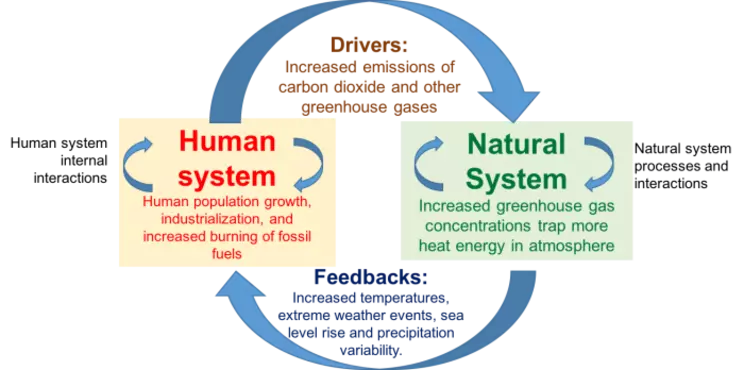For the Instructor
These student materials complement the Future of Food Instructor Materials. If you would like your students to have access to the student materials, we suggest you either point them at the Student Version which omits the framing pages with information designed for faculty (and this box). Or you can download these pages in several formats that you can include in your course website or local Learning Managment System. Learn more about using, modifying, and sharing InTeGrate teaching materials.Climate Change in the Coupled Human-Natural System
We've covered quite a bit of ground in this module. We explored how human activities have led to an increase in atmospheric carbon dioxide, which in turn is increasing the surface temperature of the Earth and changing precipitation patterns. The resulting impacts on our agricultural production system are complex and potentially negative. As a result, farmers are adopting new practices and technologies to adapt to our changing climate and create more resiliency in the agricultural system.
Let's put global climate change and its interaction with our agricultural system into the Coupled Human-Natural System (CHNS) diagram that we've been using throughout the course. The development of global climate change is illustrated in the CHNS diagram in Figure 9.2.9, where the increased burning of fossil fuels within the human system results in more CO2 in the atmosphere. The response in the natural system is that more heat energy is trapped. The resulting feedback that affects the human system is that temperature increases along with all of the other climate change effects that we discuss in this module.

Figure 9.2.9. Coupled Human-Natural System diagram illustrating the development of global climate change.
What would be the next step in the diagram? Consider the feedbacks associated with the arrow at the bottom of the diagram that will affect the human system. What are the possible responses in the human system to these feedbacks? Our response can be categorized into two broad categories: mitigation and adaptation. We've already discussed adaptation strategies that can be implemented by farmers to adapt to a changing climate. Some examples are to change the crops grown to adapt to the higher temperatures or to install more efficient irrigation systems so that crops can be grown more efficiently.
What about mitigation? Mitigation strategies are those that are targeted at reducing the severity of climate change. One important mitigation strategy is to reduce the burning of fossil fuel, and our agricultural system is a significant contributor to greenhouse gas emissions. Shifting to use renewable energy sources and more fuel-efficient equipment are two mitigation strategies. There are other important mitigation strategies that target other greenhouse gas emissions, such as nitrous oxide from fertilizer use and methane from ruminants and some types of irrigated agriculture.
In the next couple of modules, we'll talk more about strategies to make our agricultural systems more resilient and sustainable, and you'll see how our food production can become more resilient to climate change. In addition, you'll get the opportunity to explore the project climate change impacts on your capstone region and to consider how those projected change might affect the food systems of that region.


